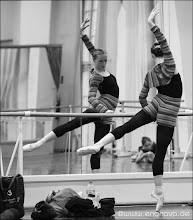Nureyev was born in Tatar, Russia on March 17th 1938. Nureyev loved to dance from a very young age, but was unable to enroll in a ballet school until 1955 because of World War II. Nureyev was sent to the Vaganova Choreographic Institute and the teachers soon noticed that he was the most gifted dancer they had seen for years, but they also noticed he had a difficult temperament.
Within two years Nureyev was one of the Soviet Union's best-known dancers, in a country which highly valued the ballet and made national heroes of its stars. It was a rare privilege for people to travel outside of the Soviet Union, but Nureyev was allowed to go to Vienna once to perform, but soon after he was restricted to leave because of his temper.
In 1961 Nureyev's situation changed. The Kirov's leading male dancer was injured, and at the last minute Nureyev was chosen to replace him on the Kirov's European tour. His performances electrified audiences and critics, but he broke the rules about mingling with foreigners, which alarmed the Kirov's management. The Union wanted to send him back to Russia again but on June 17th 1961, Nureyev defected.
Soon he was signed up by the Grand Ballet du Marquis de Cuevas and was performing major roles. Margot Fonteyn soon became Nureyev’s dancing partner and they soon became the most famous dancing “couple” still known today. Fonteyn and Nureyev were great friends, on and off stage, even though Nureyev proved to have a horrid temper that would flair up when practices did not go well.
In 1964 he came to the Vienna State Opera, where he remained as a dancer and chief of choreography till 1988. Around 1964 he became involved in filming his ballets, many of which are available to watch today on VHS. During the 1970s, Nureyev appeared in several movies and toured the Untied States in a revival of the Broadway musical The King and I. His guest appearance on the then-struggling television series The Muppet Show is credited for boosting the series to worldwide success.
In 1983 he was appointed director of the Paris Opera Ballet, where as well as directing he continued to dance and to promote younger dancers. Despite advancing illness towards the end of his career, he worked tirelessly, staging new versions of old standbys and commissioning some of the most groundbreaking choreographic works of his time.
By the end of the 1970s he moved into his 40s and his strength and ability to do such amazing dancing declined. He unfortunately continued to tackle the big classical roles for far too long, and his rather undistinguished performances in the late 1980s disappointed many of his admirers. Towards the end of his life, he was wracked with the ravages of AIDS, but he still worked tirelessly on productions for the Paris Opera Ballet.
Nureyev died in Paris France in 1992 at the age of 54.
Wednesday, October 29, 2008
Dancer Profile: Rudolf Nureyev
Posted by The_Ballerina at 7:54 PM 2 comments
Labels: dancer profile, Rudolf Nureyev
Subscribe to:
Comments (Atom)
